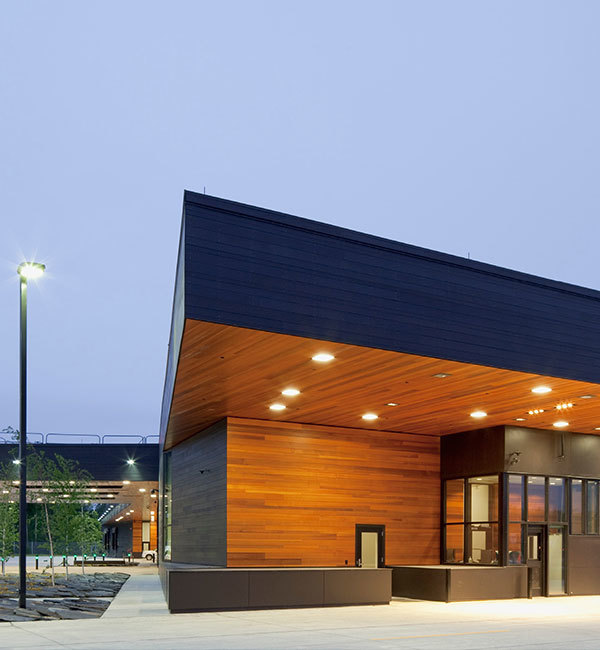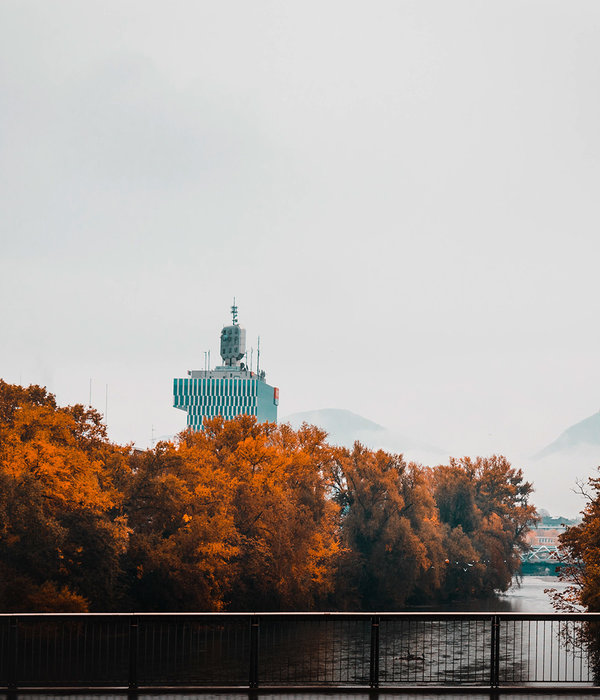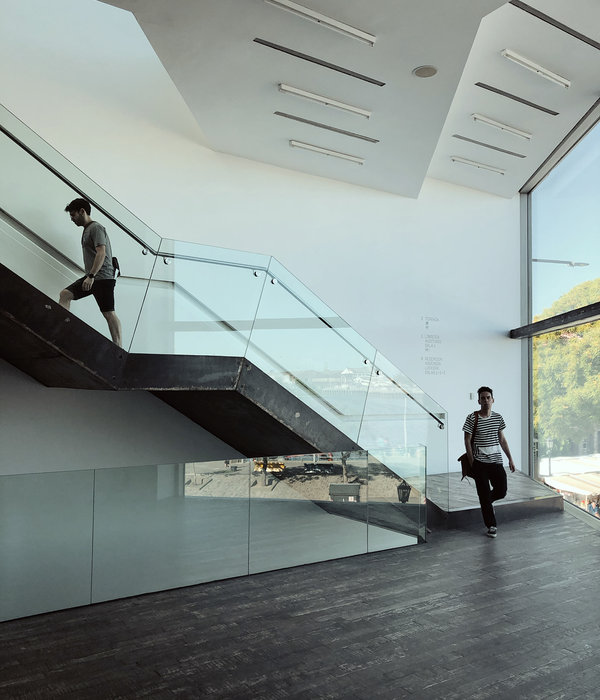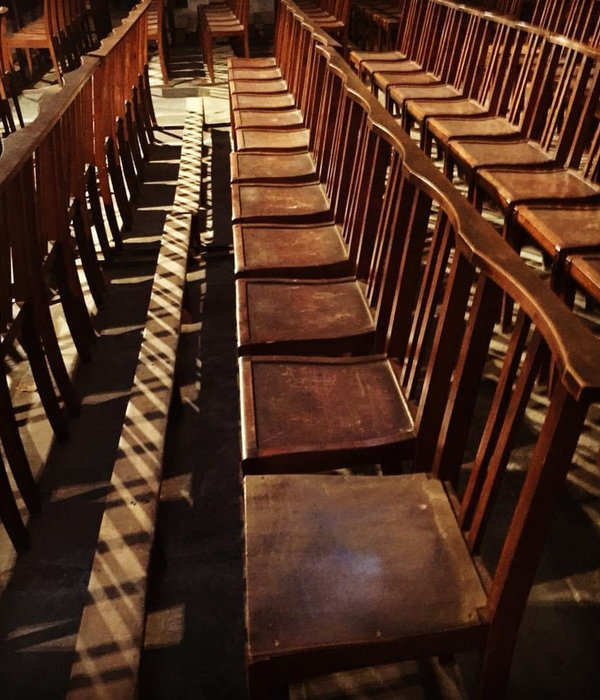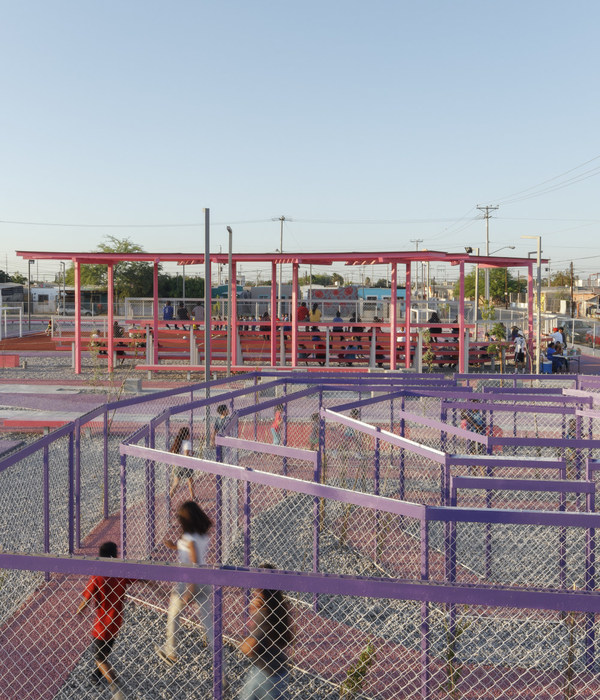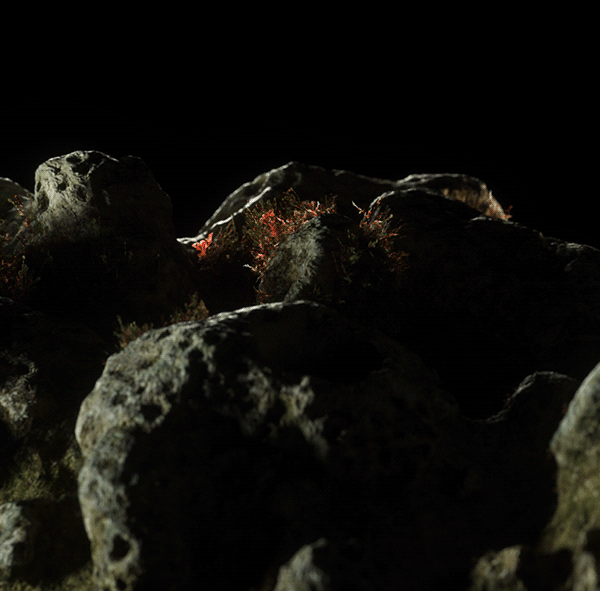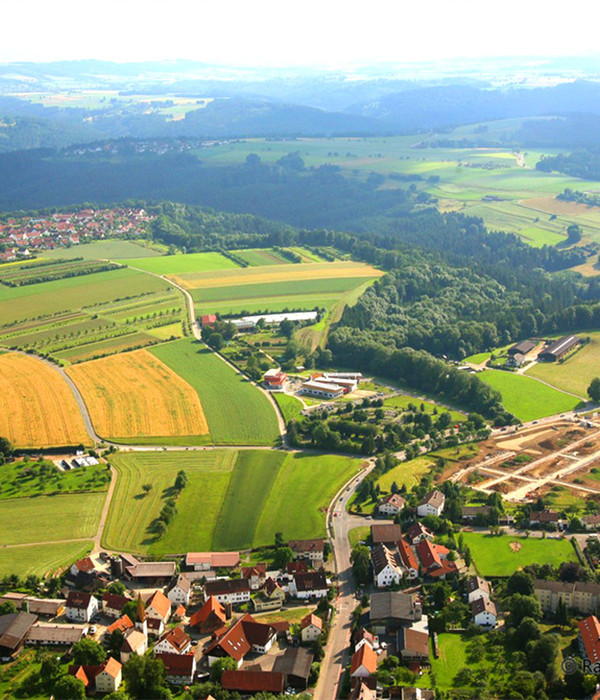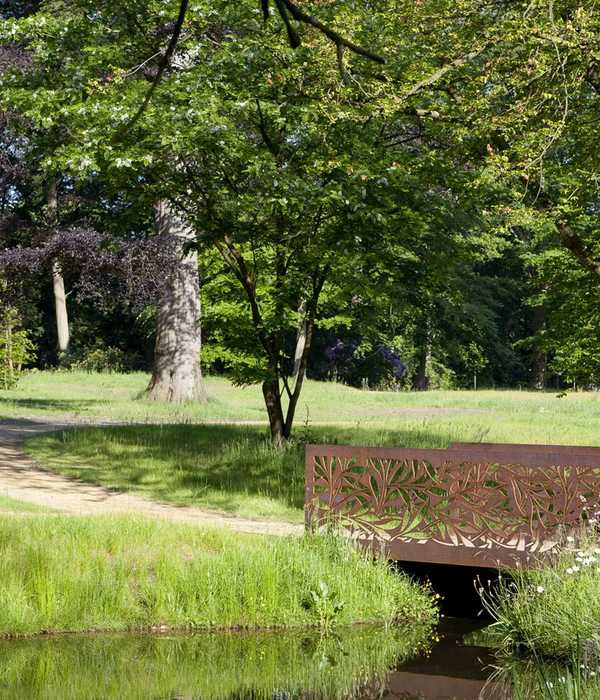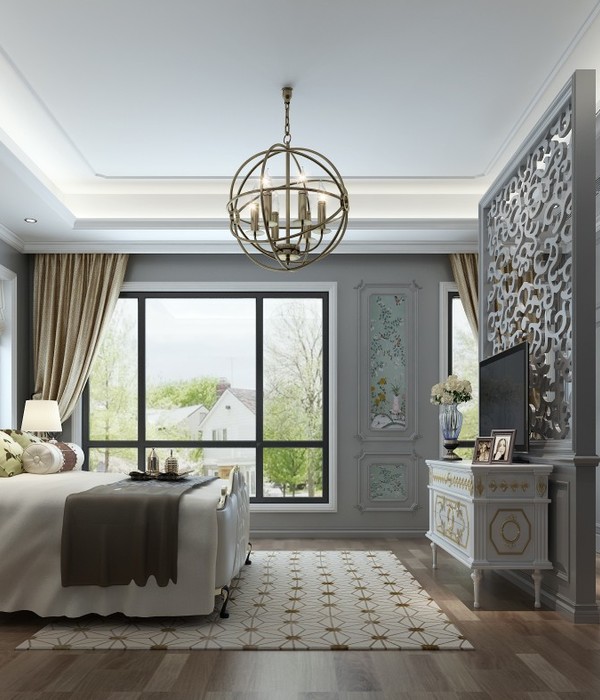“该项目让我们看到了公共路径、栖息地、历史和文化以及经济发展的结合。这是一个有着确切实施潜力的项目。” -2018年评审委员会
“Here we see the combining of public access, habitat, historic and cultural interpretation, and economic development in a project that’s very tangible in terms of its potential to being implemented.” – 2018 Awards Jury
威拉米特瀑布(Willamette Falls)是美国第二大瀑布。在过去的一个世纪,这片壮丽的景观由于河岸工业基础设施的修建而逐渐远离了人们的视野。2012年,Blue Heron造纸厂正式关闭,城市和联邦机构开始集中讨论威拉米特瀑布的规划问题,旨在保证公众能够重新进入瀑布景观。一条全新的滨水步道及其连接的一系列公共空间将引领游客重新感受瀑布和崎岖海岸线的壮美景致,近距离接触22英亩的玄武岩地貌。项目的分析、规划和落实以4个核心价值观为基础,包括公众参与、健康栖息地、经济再开发以及历史和文化诠释。滨水步道将成为一道连接西北地区历史的大门,从自然、生态、文化和地质历史等多个层面来为该区域重新赋予生机。威拉米特瀑布景观的重塑展示了该项目在自然、文化和时间概念上所作出的极为深入的思考,标志着该场地已经开启了它全新的生命篇章。
Willamette Falls is the second largest waterfall by volume in the country. For over a century, the breathtaking site has been cut off from public access by industrial infrastructure built along the water’s edge. Upon closure of the Blue Heron Paper mill in 2012, city and state agencies came together as the Willamette Falls Legacy Project to secure public access to the Falls. A new riverwalk and its sequence of public spaces will allow visitors to rediscover the full height of the Falls and its rugged shoreline, uncovering swaths of the 22-acre site’s basalt topography and reconnecting Oregon City to its spectacular waterfront. Grounded in four core values, the analysis, planning, and resulting design of the project targets Public Access, Healthy Habitat, Economic Redevelopment, and Historic and Cultural Interpretation. The riverwalk will serve as a portal to the Northwest’s history, reviving its aggregated layers of natural, ecological, cultural, and geological history. The reimagining of Willamette Falls in its fullest depth in nature, culture, and time, opens a new chapter in the life of the site.
▲威拉米特瀑布场地原貌。Willamette Falls Existing Conditions
位于俄勒冈州的威拉米特瀑布遗产地包含50多栋工业建筑,其间分布着各类已经退化的自然栖息地,并与威拉米特河的河漫滩形成部分连接。场地的南端地块以及威拉米特瀑布本身均为波特兰通用电气公司(PGE)所有,属于大坝建设的一部分。场地本身包含了诸多机会和挑战。其中机会体现在与美洲原住民部落及其文化的紧密连接、俄勒冈州丰富的历史资源、西部的工业和发电历史,以及一条能够近距离接触瀑布的水坝走道;挑战则在于有害的建筑材料、洪水风险、州政府和联邦政府在鱼类和野生动物保护方面的条例,以及在大坝上施工的难度。
从俄勒冈城历史悠久的市中心起始,一直到瀑布的顶端结束,规划将威拉米特瀑布的滨水步道构想为一个从古老的玄武岩、工业钢材、混凝土和木材中雕刻而出的群岛景观。新的设计将整个场地视为一个整体,并由走廊和架空步道构成的网络实现物理层面的连接。从项目的初期阶段开始,由俄勒冈城市政府、克拉克马斯县政府、俄勒冈铁路部门以及俄勒冈州政府共同构成的合作团体便制定了以四个核心价值观为基础的指导方针。作为整个项目的支柱,这四个核心价值观为分析和规划过程中的所有决策提供了框架,并将继续指导项目在未来的实施。
该项目经历了长达2年的复杂的设计过程,得到了成千上万名公众的参与和支持。规划过程涉及到众多利益相关者,其中包括项目合作伙伴、与瀑布场地联系紧密的联盟部落、波特兰通用电气公司、私人土地所有者以及当地社区等等。基于一系列大规模、创新性的公众会议,设计团队得以从现场和网络等多种渠道获取来自公众的极具价值的反馈。
这些公众共同参与的规划和沟通实践成功地刺激了各界的参与,并为利益相关者提供了有效的反馈循环。这是一个富有创新性和远见的实施过程,来自社会各界的积极反馈和支持使得项目获得了大范围的成功,并成为一项具有重要意义的公众参与的示范案例。
各方参与者表达了他们希望“感受瀑布的力量和弥漫的水雾”以及“将双脚踏入水中”的愿望,设计团队基于这些想法,致力于为游客提供一系列能够与瀑布亲密互动的路径和空间,在游客与场地之间建立物理和情感上的双重联结。
威拉米特瀑布是许多濒危物种和各类动植物赖以生存的家园,基于这种敏感的环境,设计团队需要谨慎考量方案的每一个细节要素。通过与栖息地科学家的密切合作,威拉米特河流域的各种栖息地类型得以分析出来,从而帮助设计团队确定可以开发的区域,同时创造在现场恢复植物和苔藓物种的集会。
威拉米特瀑布周围每年都会发生季节性的动物迁徙。项目团队调研了当地鸟类、鱼类和哺乳动物的繁殖模式、现有栖息条件以及水电站大坝的运作情况,从平面和剖面两种视角分析了规划和介入的可行性,以确保可以选择性地移除原先的工业建筑和台地,并恢复特定区域的生态系统。方案中规划的入口位置和探出水面的岩石能够帮助鲑鱼和其他鱼类提供迁徙至瀑布上游的水道。这些举措旨在为场地赋予一种独特的生态活力,为濒临灭绝的野生物种提供保护。场地中将有5个栖息地得到恢复,从而保护使7个濒危或敏感的物种得到保护。此外,威拉米特河流域生存着60种鱼类,其中有31种属于本地物种。
在一年之中,河流的水位通常会出现25英尺左右的波动。水文学专家研究了极端水流可能对设计造成的影响,以帮助制定潜在影响较低的设计策略。团队与专家共同构建了场地的水文模型,并以1996年的洪水事件为参照,对每个设计方案进行了测试。因此,新的公共空间和结构均能够承受和适应普通水流和极端的洪水冲击。不仅如此,滨水步道的结构还得到了进一步的加固,以便应对可能发生的地震。步道的支撑结构很好地利用了场地现状,能够最大程度地减少建筑在垂直方向上的使用,并降低其对下方刚刚恢复的玄武岩河岸栖息地造成的影响。
对于既有工业建筑的选择性拆除不仅旨在恢复健康的动植物栖息地,还在于使公众重新访问一系列对国家有着重要意义且能够反映太平洋西北地区工业历史的独特建筑。对于场地文化的深入理解已经延伸到了当地的五个部落,他们将继续保持其自古以来的传统,每年在附近的水域进行捕捞作业。
由项目催生出的“文化景观报告”提供了一个基础性的知识库,它重点关注了场地的历史,并结合以大量的档案研究、数百张历史照片以及一系列场地调查。另外一份“解释性计划纲要”将通过滨水步道的设计来引导场地历史的走向。这种针对文化和历史资源进行的严格分析为场地的优化奠定了重要基础。通过谨慎的干预和修正,该项目将重新寻回那些借助瀑布的力量而发展起来的行业历史,包括毛纺、面粉和造纸业,以及各种依靠电力运行的体系;同时也将进一步突出场地在历史、文化、生态和经济等方面的重要意义。
不同于许多后工业的滨水项目,威拉米特瀑布将作为发电设施继续发挥作用。波特兰通用电气公司将作为场地中的重要组成部分继续运营,并对滨水步道的实际体验产生积极的作用。项目团队与波特兰通用电气公司进行了密切合作,确保设计一方面能够充分容纳水闸的运作和维护,一方面又能够为游客提供全年欣赏瀑布的机会。
自概念设计公布以来,设计团队与项目合作伙伴共同开发了一个适用于公共基础设施的框架,它能够将滨水步道与高处的场地充分地结合起来。这一整体性的方案涵盖了街道的优化设计、场地循环、污水处理以及雨水管理等内容。
公共设施的升级将为经济再开发的目标提供支持。为了实现提高公共参与度的目标,设计团队正在分析将俄勒冈城的主干道扩展到场地内部的可行性。这一做法将重新连接俄勒冈城的市中心以及历史城区的核心地带,并使场地保留住其原本的特色。
▲场地概貌-既有场地鸟瞰。在过去的一个世纪,这片壮丽的景观由于河岸工业基础设施的修建而逐渐远离了人们的视野。城市的主干道在场地和城市的其他区域之间形成了阻隔。Overall Site – Existing Site Conditions, Aerial Photograph.The site encompasses the location of Oregon City’s historic downtown. Over time, industry overtook the shoreline. For the past century, the waterfront has been inaccessible to the public. Main Street today dead-ends at the site area, sequestering it from the rest of the city.
▲场地概览- 设计提案。新的设计将整个场地视为一个整体,并由走廊和架空步道构成的网络实现物理层面的连接。谨慎的场地策略使历史悠久的海岸线以及动植物栖息地得到了恢复,同时为观赏瀑布提供了广阔的视野。Overall Site – Proposed Design, Illustrative Plan. The design treats the whole site as a single landscape, with a network of pathways that lace through the physical strata of the site. Sensitive site editing through strategic removal of structure restores the historic shoreline, allowing animal and plant habitats to flourish while providing expansive views to the falls.
▲该方案得到了数千名参与者的支持。图中展示的是2015年和2016年的社区活动,由团队发起的研讨会获得了来自多方参与者对于滨水步道设计提出的反馈。Community Outreach. The design was underpinned by a significant public engagement effort that has reached thousands of participants. Pictured: 2015 and 2016 community events, where workshops facilitated by the design team solicited feedback on the desired key riverwalk uses and design alternatives.
▲对滨水步道场地环境的综合性分析。图中展示了当地鸟类、鱼类和哺乳动物的繁殖模式、现有栖息条件以及水电站大坝的运作情况。Synthesizing community input on riverwalk uses and environmental data, this graphic calendar depicts the seasonal activities that take place over the course of a year on-site, including migratory and breeding patterns of native species, PGE Operations, waterflow, and existing habitat conditions.
▲在北部河滨地区,1860年代面粉厂所在区域的台地结构被剥离出去,使古老的玄武岩地貌暴露出来。架空的路径使游客能够穿越场地,感受被恢复的栖息地的美景。In the North Riverfront area, existing structures and platforms are peeled away to expose the outcrop of ancient basalt on which the historic 1860’s Flour Mill was constructed. An elevated explorer trail draws visitors through the area alongside restored habitat.
▲游客可以沿着长廊抵达公共庭院。这里是一个宽阔的广场,可以欣赏到瀑布的壮观景色。庭院及其周围的建筑提供了灵活的公共空间,为俄勒冈城带来了一个全新的市民中心。Visitors following the main promenade arrive at The Public Yard, a broad plaza with expansive views toward the falls. The Yard and adjacent structures provide a flexible public space where people can congregate in a new civic heart for Oregon City.
▲架空的步道跨越下方的毛纺厂放水渠,与场地中既有的工业建筑相连。锅炉房和H工厂被保留下来以展示其历史用途,形成一个拥有瀑布视野的新目的地。A lofted pathway passes over the restored Woolen Mill tailrace connecting to retained industrial structures that are preserved to showcase their history of uses. Together the Boilers and Mill H structures provide a riverfront destination with a falls viewpoint.
▲高架的探索步道一路向南延伸,将H工厂与沉淀池、波特兰通用电气公司大坝与发电站A以及Hawley电站等历史工业建筑以及位于尽头的瀑布景观连接在一起。The sequence of elevated explorer trail pathways extends south like stepping stones, connecting Mill H to the Clarifier, to PGE Dam at Station A, to the final overlook over the falls at the historic Hawley Powerhouse Foundation.
▲三个剖面图阐释了路径设计的多样性。这些路径为玄武岩基岩上的栖息地提供了恢复的机会,同时使既有的人行通道得到了有效利用。左起顺时针方向分别是:主要长廊步道;探索步道;拟定的大坝路径。These sections illustrate the diversity of proposed pathways that provide opportunities for habitat restoration on the basalt bedrock and repurpose existing structure for pedestrian access. Clockwise from left: main promenade; explorer trail, and proposed dam pathway.
▲工业化的河岸建设削弱了海岸线的生态价值。滨水步道的设计选择性地移除了原先的工业建筑和台地,旨在恢复特定区域的生态系统。该图揭示了毛纺厂与河岸及水力发电的历史渊源。Today’s industrialized river edge diminishes the ecological value of the shoreline. The riverwalk design carves away industrial fill and structural platforms to restore region-specific ecosystems. This particular alcove reveals the Woolen Mill’s historic relationship to the river and source of water power.
▲毛纺厂观景平台是主街道的公共终点站,在这里可以获得观看PGE大坝、锅炉房建筑群、修复后的河道以及公共庭院的全景视野。The Woolen Mill Overlook serves as the public terminus of Main Street, offering 360° views of PGE dam, the historic boiler complex, the restored river alcove and The Public Yard.
▲既有的H工厂的建筑包层被剥离以带来不受阻碍的观景视野。重新被利用起来的混凝土基座充分敞开于自然环境。原生的针叶树林使人想起与造纸工业有关的场地历史。The corrugated cladding of the existing Mill H structure is peeled away to offer prominent views. Opened to light and air, its repurposed concrete foundation supports a grove of native conifers, referencing the historic paper-making processes that once took place here.
▲净化池原先服务于Blue Heron造纸厂,其外部被设想中的人行步道环绕。内部景观的设计灵感源于当地的橡树草原栖息地。在大坝走廊维修或关闭时,游客可以通过人行步道进入瀑布景观。The clarifier, a water quality treatment structure once used by Blue Heron Paper, is ringed by a proposed walkway. The landscape interior is inspired by the region’s oak savanna habitat. This pathway allows full public access to the falls when the PGE dam promenade is closed for operations and maintenance.
▲滨水步道的设计充分利用了Hawley电站所在位置的陡峭地形。游客可以站在瀑布的边缘,充分享受水雾弥漫的神奇体验。The destination overlook of the riverwalk takes advantage of the precipitous location of the historic Hawley Powerhouse Foundation. At the brink of the falls, visitors are immersed in a tactile experience that celebrates the presence of the falls.
The Willamette Falls Legacy Project site in Oregon City contains more than 50 industrial buildings, various degraded natural habitat areas, and is partially within the Willamette River floodplain. At the southern end of the project site, and on Willamette Falls itself, is a dam owned and operated by Portland General Electric (PGE). The site presents many opportunities and challenges. Opportunities for the riverwalk include strong ties to Native American tribes and culture, a site rich with the history of the Oregon Territory, the industrial west and power generation, and a fully operational dam walkway that can draw visitors close to the Falls to feel the mist and hear the roar of the water. Challenges for site development include hazardous building materials, flooding risks, state and federal protection of fish and wildlife species and dam operations.
Beginning at the entrance to Oregon City’s historic downtown and ending at the crest of the Falls themselves, the proposed Willamette Falls riverwalk is conceived as a sequence of islands, an archipelago carved from ancient basalt and industrial steel, concrete, and wood alike. The new design treats the whole site as a single landscape, with a network of promenades and lofted pathways that lace through the physical strata of the site. Since its earliest phases, when the Partners Group–comprised of Oregon City, Clackamas County, Metro and the State of Oregon–first came together in 2012 to bring back access to the Falls, the project has been guided by four core values. As grounding pillars that laid the foundation for the design, these four core values have been used as a framework for all decisions in the analysis and planning of the project, and will continue to guide future decisions as the project is implemented:
The design is the culmination of a complex two-year design process, underpinned by a significant public engagement effort that has reached thousands of unique participants. The planning process engaged a complex group of numerous stakeholders that included the Project Partners, five confederated tribes who have historic and present-day ties to the Falls, Portland General Electric, a private land owner, and the local community. Through a series of large-scale, innovative public engagement meetings, the design team was able to collect and meaningfully integrate feedback from the public via in-person and online participation.
These public engagement planning and communication practices were successful in piquing interest, inspiring involvement, and providing feedback loops for stakeholders. The innovative, large-scale scope and success of the process—as shown by large participation numbers, positive stakeholder feedback, and broad public support of the final design—have made this project a model for intentional and meaningful public involvement.
The community outreach data collected on the desired key riverwalk uses per season included: hiking trails, historic re-use, Willamette Falls viewing access, natural restoration, and water activities. Stakeholders expressed a consistent desire to “feel the power and mist of the Falls” and be able to “put their toes in the water.” The design synthesized these key ideas by prioritizing a physical and emotional connection to the site, providing spaces where visitors can be close to the falling water, feel the spray, and access paths to the water.
Home to endangered species and diverse flora and fauna, Willamette Falls’ sensitive and powerful environment required the design team to calibrate a host of considerations. The design team worked closely with habitat scientists who identified the various habitat types throughout the Willamette River Watershed Region. This data allowed the design team to identify areas where these habitat types could be developed, creating opportunities to restore plant and bryophyte species on site.
Various seasonal activities take place over the course of a calendar year at the Willamette Falls site. The project team collected data on breeding patterns of native bird, fish, and mammal species, existing habitat conditions, as well as PGE hydroelectric dam operations and waterflow. This allowed the design team to analyze and prioritize the site both in plan and in section, identifying areas where the design could selectively carve away industrial fill and structural platforms to restore region-specific ecosystems, such as alcove and riparian basalt habitats. Proposed inlets and exposed rock outcroppings provide critical off-channel moments for migratory salmon and other fish species to rest before they undertake their passage upstream beyond Willamette Falls. These efforts aim to establish an ecological vitality unique to the site and in service to endangered wildlife species. Within the site, five unique habitats will be restored, while protecting seven threatened, endangered, or sensitive species. Additionally, 60 fish species thrive in the Willamette River Basin, 31 of which are native species.
Over the course of a year, the river levels typically experience a fluctuation of approximately 25 feet. Expert hydrologists studied the effects of extreme flooding on the new design to help formulate a strategy to mitigate its potential impact. They created a hydrologic model of the existing site, calibrated to the 1996 flood event, against which each of the design options were tested. Thus, the public spaces and adaptively re-used structures of the project are designed to withstand and accommodate both regular flooding and extreme flood events. Further, the riverwalk sequence will be reinforced to withstand seismic activity within its location in a seismic zone. Pathway structures will be engineered to take advantage of existing site structures for support, minimizing the use of vertical construction and reducing impacts to the restored riparian basalt habitats below.
The selective removal of industrial structure not only aims to restore healthy animal and plant habitats within the retained structures and on the basalt bedrock of the site, but also provide public access and interpretation of a unique set of nationally important historic structures that charted the industrial history of the Pacific Northwest. This cultural understanding of the site extends to the five confederated tribes who will continue to annually fish the waters as they have done since time immemorial.
A Cultural Landscape Report provided a common knowledge base that focused on the site’s history, combining extensive archival research, hundreds of historic photographs, and site investigations. Another report, the Interpretive Framework Plan, will guide the stories to be told on site through the riverwalk design. This rigorous cultural and historic resource analysis laid the groundwork for prioritizing the site. Through sensitive site editing, the project will make recognizable once again the history of the various industries that once harnessed the power of the Falls, including the woolen, flour, paper, and power operating structures; highlighting the site’s historical, cultural, ecological and economic significance.
Unlike many post-industrial waterfront projects, Willamette Falls will remain as an operational, power-generating facility. PGE will remain in operation as an active component of the site and part of the authentic riverwalk experience. The project team collaborated closely with PGE to ensure that the design can accommodate dam closures for operations and maintenance, while still providing access to the Falls year-round.
Since the public release of the conceptual design, the design team has collaborated with the Project Partners to develop a framework for public infrastructure that will integrate the riverwalk with upland portions of the site. This holistic approach incorporates strategies for improved street design, site circulation, sewage, and stormwater management.
Upgrades to public utilities will feed into the projects economic redevelopment goals. In tandem with the project’s overall goals to improve public access, the design team is currently analyzing options that will extend Oregon City’s Main Street into the site, reconnecting downtown Oregon City to the heart of its historic center while maintaining the character of the site.
{{item.text_origin}}

